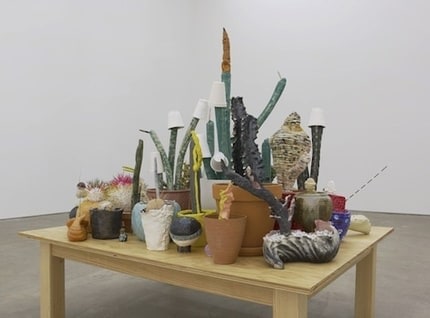
In her latest exhibition, “Surplus,” Lisa Sanditz equates gestural landscape paintings with a series of quirky ceramic cacti. This particular dialogue highlights the materials of both practices, emphasizing hierarchies between art and craft. Sanditz’s paintings command a vocabulary of styles and surface treatments that could easily lead to disaster in less trained hands. The Salad Kings, 2013, places a precisely rendered home within a squeegeed void that recalls Gerhard Richter. Meanwhile, Rotting Halloween, 2013, and Farms Houses/Edge, 2014, work between the baseness of Georg Baselitz and the more delineated figuration of Philip Guston and Amy Sillman. The cacti extend this experimental blending: In Cacti Display, 2014, Sanditz punctuates a naturalistic green palette with sherbet mattes, acid pinks and dazzling metallic glazes until the idea of these forms as representations becomes muddy, a move that emphasizes the tension embedded in terms such as biomorphic or even abstract.
Echoing recent exhibitions of Saira McLaren and Allison Schulnik, as well as Nicole Eisenman and Erika Verzutti at the 2013 Carnegie International, “Surplus” mobilizes the concept of craft to challenge its status in the context of fine art. Works such as Slumped Cactus, in which clay appears to pour forth from a cup suspended in midair, evoking Lynda Benglis, or Dead Heads, both 2014, a hanging planter filled with small forms that would appear equally at home on the patio of a retirement community as in Henry Moore’s workshop, demonstrate the way ‘crafty’ can also denote strategy, that which outwits hierarchical categories by collapsing them into one another. In Pink Slime, 2012, thick tracks of pink paint squeezed from the tube expand like a tumor around a lightly rendered oil sketch of a suburban office building. One is tempted to find allegory here. A farce on the tired metaphor of modern painting as a delimited chessboard that has run out of moves, Sanditz’s “Surplus” suggests that materiality knows no endgame.
Written by Grant Johsnon